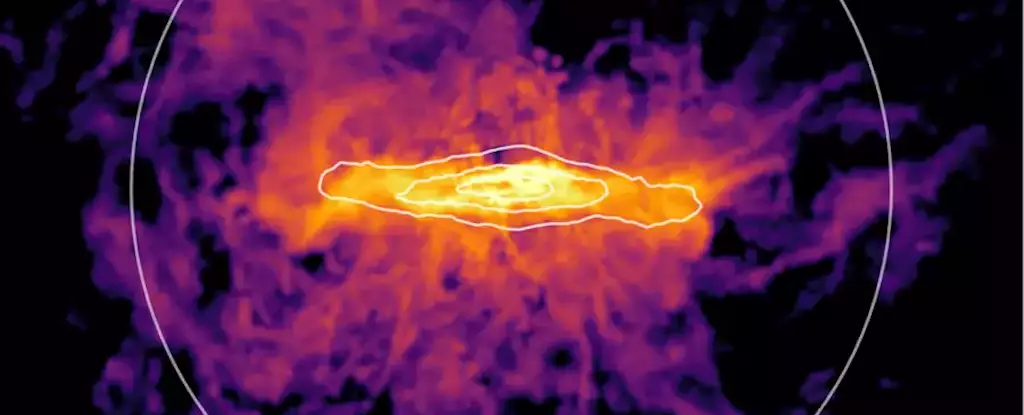Carl Sagan once eloquently asserted that we are composed of “star-stuff,” a mantra that captures the essence of our connection to the universe. Yet, recent studies have unveiled a more intricate narrative about the journey this “star-stuff” undertakes before culminating in the composition of life on Earth. New data from the Hubble Space Telescope reveals the astonishing pathway of carbon – a fundamental building block of life – suggesting that it may have traversed hundreds of thousands of light-years beyond our galaxy, only to return and become part of us.
The process by which elements heavier than helium are created is grounded in stellar evolution; these essential elements are forged in the tumultuous heart of stars. Upon exhausting their nuclear fuel, stars explode in cataclysmic supernovae, dispersing their elemental treasures into the vastness of space. This expelled material is not merely cast away; it enriches the interstellar media, becoming the raw ingredients for the subsequent generation of stellar bodies, planets, and potentially, life.
The Circumgalactic Medium: A Cosmic Highway
A remarkable aspect of this cosmic cycle involves the circumgalactic medium (CGM), an enormous gas cloud encompassing galaxies. Recent research indicates that carbon – the very element foundational to our existence – often journeys into this immense reservoir, spending considerable time outside the galaxy before being reacquired. Jessica Werk, an astronomer at the University of Washington, underscores the implications of these findings for our understanding of galaxy evolution and carbon availability: “The same carbon in our bodies most likely spent a significant amount of time outside of the galaxy!”
By scrutinizing the CGM around 11 star-forming galaxies, scientists detected robust signals of carbon that extended as far as 391,000 light-years from the galaxy’s center. This distance is particularly impressive when considering that the Milky Way’s visible disk measures approximately 100,000 light-years across. Samantha Garza, the study’s lead author, likens the circumgalactic medium to “a giant train station,” where materials are continuously ejected by supernovae but are also drawn back in, perpetuating the cycle of star and planet formation.
Every element has a distinct fingerprints when it interacts with electromagnetic radiation, absorbing different wavelengths of light. The researchers skillfully employed Hubble’s Cosmic Origins Spectrograph and analyzed light emitted from nine distant quasars to trace the elusive carbon present in the CGM. This novel detection of carbon, juxtaposed with previously established knowledge of ionized oxygen in circumgalactic mediums, highlights the intricate dance between different elemental cycles in galactic environments.
Importantly, the study reveals that not all galaxies share this robust conveyor belt of materials. Active star-forming galaxies demonstrate a higher circulate of carbon compared to their passive counterparts, which do not generate new stars as vigorously. The correlation between the CFMs of star-forming galaxies and their enhanced oxygen content reinforces the view that these interstellar environments serve as critical reservoirs, supporting ongoing star formation processes.
Our own Milky Way galaxy, still teeming with ongoing star formation, is likely the repository of carbon and oxygen that has journeyed through intergalactic space at least once. This fascinating interplay raises critical questions for astronomers eager to unravel the mysteries surrounding the initiation and cessation of stellar formations. Moreover, the dynamics of the CGM could elucidate the phenomena that unfold during galactic mergers – a future that awaits our Milky Way.
As we contemplate the cycles of star materials, the cyclical journey of carbon adds layers of depth to Sagan’s famed proclamation. The essence of life within us is not a static inheritability but rather a vibrant tale of survival, transit, and transformation through the cosmos. The “star-stuff” we cherish did not just settle into existence; it undertook a profound journey through the universe, gathering experiences before returning to form the very fabric of life on Earth.
In essence, the incredible voyage of carbon not only enriches our understanding of life’s ingredients but also deepens the bond we share with the universe. Indeed, as we consider our cosmic heritage, we celebrate the shared history that binds us to the stars, illuminating the magnificent journey that has ultimately forged humanity from the remnants of ancient stellar giants.


Leave a Reply